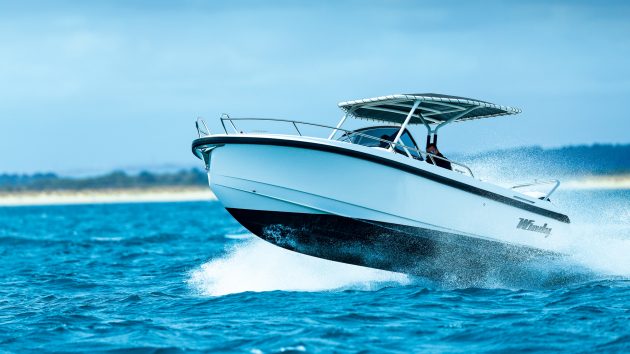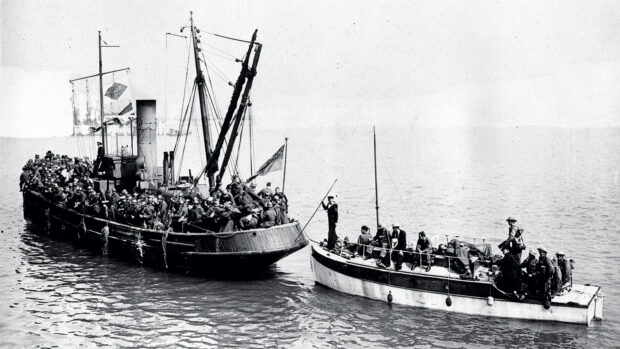Windy’s latest entry-level sportsboat, the Windy SR28 CC, promises the same world-class driving dynamics as its big sisters in a smaller, more affordable package
Windy may be best known for its sleek, sterndrive-powered sportscruisers but it has also been building a handful of smaller outboard-powered sportsboats much longer than most people give it credit for, and the Windy SR28 CC is another model to add to the range.
The first Windy Oceancraft 760 was launched way back in 1999 followed by the Draco 27RS in 2014. Both were well received by journalists at the time for their terrific hull dynamics and robust build quality, but the former was arguably ahead of its time and hampered by old-tech outboard engines while the latter was overshadowed by the arrival of another equally capable but more affordable newcomer – the original Axopar 28.
Ten years on and the balance has shifted once again. Not only has Windy launched this much more versatile SR28 CC model but Axopar prices have been steadily creeping up to the point where there is no longer a vast gulf between them.
Prices for the Windy SR28 start at £162,952 inc VAT with a state-of-the-art Yamaha F300 outboard, while a similarly specced Axopar 28 is only around £10-15k less.

Photo: Paul Wyeth
Hull design
It would take a proper boat geek to spot it but the new SR28 CC actually uses the same hull as the old Draco 27RS. There’s no shame in that as it’s a particularly good example of what Windy has always done best; designing sweet-running, stepless hulls with relatively deep vees and slender beams for a soft, agile ride matched to fast, fuel-efficient cruising.
The Windy SR28’s beam of 8ft 2in is almost 18in narrower than an Axopar 28’s, for example, and features a 20° deadrise angle at the stern to help it cut through the waves.
That’s pretty much the only thing it shares with the Draco, though, as from the deck upwards it’s an all-new boat. Out goes the old bow rider design, with its low slung walk-through windscreen and rather exposed helm and seating layout, and in comes a much more practical walkaround layout with a centre console helm, sociable dinette seating at both ends, a surprisingly decent cuddy cabin and an optional T-Top.
Article continues below…
It’s so much better than the original, you can’t help wondering how they managed to squander all that space the first time around. The really clever thing is that it looks prettier too, giving that edgy snub-nosed bow and long, low sheerline the dynamic profile and more sophisticated finish it deserves.
It’s not just the looks Windy has got right, it’s the practical aspects too. The two big deck lockers either side of the rear seat for instance are fitted out with deep mesh baskets so you can chuck your wet ropes, fenders or swimming gear in and let them drain away into the bilges, but when the time comes to retrieve them you can lift out the whole basket rather than rummaging around on your hands and knees.

The forward dinette converts to a sunpad with the aid of a drop down table. Photo: Paul Wyeth
The seat itself also has a reversible backrest so you can sit facing forward under way but then flip it over to enjoy the view aft at anchor or keep an eye on a wakeboarder.
All Windy SR28’s come with a heavy duty watersports arch featuring a nice high tow point as standard that doubles as a convenient handhold when stepping on or off the twin bathing platforms.
There are more handholds under the rear seat and on both sides of the centre console, while the T-Top, windscreen surround and bow rails all provide further steadying points when moving through the boat.

The canvas T-Top is a fairly pricey option but adds useful shade and extra handholds for passengers. Photo: Paul Wyeth
As with all the stainless steel fittings on the boat, especially the three oversized cleats along each side, these all feel larger in diameter and more robust than they would normally be for a craft of this size. Our only safety-related criticism is that there didn’t appear to be an option for transom gates to shut off the cockpit from the bathing platforms – not a problem for adults but something parents of younger children may look for.
Unlike the Saxdor 270, there is no option for a cockpit wet bar either but the RS Premium pack does include a fridge under the rear seat and a host of other handy features, such as a bow thruster, artificial teak decks, anchor windlass and a full suite of cockpit and underwater lights among other things.

Deep windscreen provides good protection for the helm. Photo: Paul Wyeth
Sliding helm and co-pilot seats that swivel through 180° to create a sociable dining area are a nice touch, but being mounted rather higher than the rear seats they don’t leave a lot of thigh clearance under the table. The table itself also needs some attention as the
self-tapping screws on our test boat gave way when a crew member leant on it for support.
Perhaps a removable table top and/or an adjustable leg support would help. Our only other gripe, and one which is shared with many other centre-console craft, is that there is only secure seating for four or at best five people in the aft cockpit.
You could have two or three more sitting up front but we wouldn’t want to rely on that under way in anything other than calm conditions.

Fridge under the rear seat. Photo: Paul Wyeth
Helm and cabin
The helm, on the other hand, is pretty much perfect with excellent protection from the deep windscreen and flawless ergonomics, including supportive, reach adjustable seats with flip-up bolsters and a tilting wheel for comfortable driving seated or standing.
Zipwake automatic trim tabs are standard and the combination of a single big Raymarine touchscreen MFD and Yamaha’s smaller engine display with analogue switches for essential gear like bilge pumps, horn and nav lights looks clean but makes everything quick to find and intuitive to use.

The helm seats adjust for reach and provide good support whether seated or standing. Photo: Paul Wyeth
Deep walkaround decks on both sides give easy access to a secure bow lounge, where a larger and arguably more comfortable dinette arrangement has seating around all four sides of a height adjustable table. This also drops down to cushion level and, with the aid of fill-ins, converts the whole area into a full-length sunpad.
A sliding door next to the helm leads down to the cuddy cabin. As expected this is pretty snug, with enough headroom to sit but not stand at the foot of the bed. There’s a decent amount of natural light streaming in through an eye-level window in the bow footwell.
The cabinet next to the companionway provides dry storage, but far more valuable is the separate heads compartment opposite. It’s pretty tight in here and involves backing in bum first but that’s a small price to pay for the privacy and convenience of a proper toilet with a fresh water sink.

Separate heads compartment is a luxury on this style of boat even if it is quite small. Photo: Paul Wyeth
Windys are first and foremost drivers’ boats and the SR27 is no exception. On a blustery day off Old Harry Rocks, this game little boat behaved more like a bigger and more accomplished craft than its diminutive proportions suggest. Its deep-vee hull felt beautifully balanced and robust, skipping confidently over the waves, landing softly, staying dry and never once creaking or shuddering at the treatment we were doling out.
It would take a back-to-back group test to confirm it but we’d rate this right up there with the Cormate T28 as one of the best handling sportsboats on the market, and a step above both the Saxdor 270 and Nimbus T8.
Without steps to loosen its grip on the water it wasn’t quite as quick or fuel efficient as some rivals, topping out at 37.5 knots, but the blustery conditions may have had something to do with that and you can always opt for the twin 200hp set-up (a relatively modest £4,270 extra) if you want more speed.
The flip side is that it also feels more planted through the turns, tracking round at full speed with the perfect amount of slip and no hint of the dreaded spin-out that can affect some stepped hulls. The steering weight and gearing is bang on too, although we found the throttle overly sensitive and the engine note a little more intrusive than the latest 300hp Mercury Verado V8.

It feels more planted through the turns with no hint of the dreaded spin-out that can affect stepped hulls. Photo: Paul Wyeth
Windy SR28 CC verdict
Even we were taken aback at how capable and entertaining the SR28 CC is. It’s a much better, more rounded boat than the Draco 27RS was and deserves a far bigger audience.
Whether it will still end up being overshadowed by its inboard-powered siblings and undercut by its cheaper Finnish rivals remains to be seen but if you’re looking for something a bit more exclusive than the mainstream offerings with the dynamics and build quality to back up that premium pricing, we’d have no hesitation in recommending this born again beauty.
Windy SR28 CC specifications
LOA: 27ft 8in (8.43m)
BEAM: 8ft 2in (2.49m)
DRAFT: 3ft 3in (1.0m)
DISPLACEMENT: 2,800kg inc engine
FUEL CAPACITY: 300 litres
ENGINES: Single 300hp or twin 200hp Yamaha outboard
RCD: C for 8 people
Windy SR28 CC costs and options
Price from (1 x Yamaha F300): £162,952 inc VAT
Upgrade to twin Yamaha F200: £4,270
RS package (windlass, bow thruster, fridge, teak deck, underwater lights, antifouling, fwd table, mooring kit): £21,144
Raymarine 350 MFD: £1,474
T-Top: £6,912









